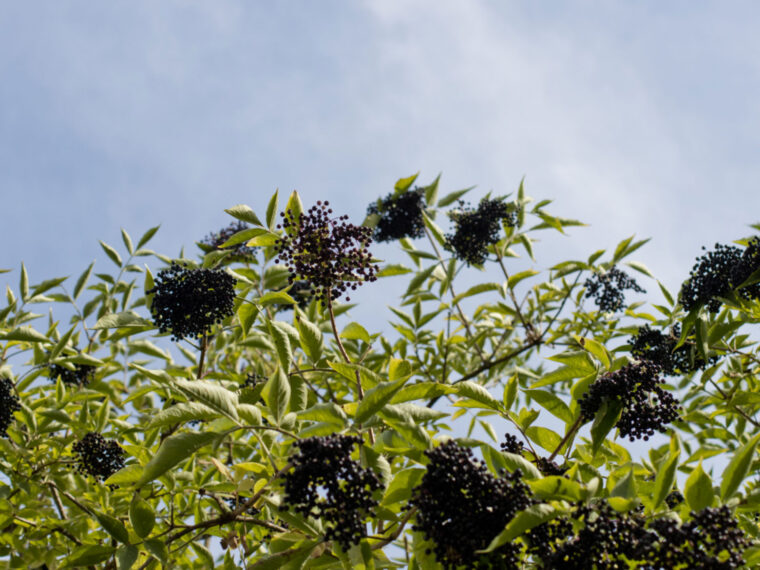
…mit wenig Gebackenem, einer abgegebenen Masterarbeit (!!!), zwei Lokalen (Recnicek und Sign Lounge), einem Buch (Veza Canetti-Biografie), einer Comicausstellung – und wie immer, den besten Links der letzten Wochen.
Seit dem letzten Zuckersüß habe ich Kokos-Mochi-Muffins (Rezept von letztem Sommer), Tahini-Ahornsirup-Zimt-Cupcakes und Schokokekse mit Erdnussbutterfüllung (Rezept von 2019) und zusätzlichen Zuckerstreuseln gebacken. Außerdem habe ich versucht, mit Blue Curacao Schlumpfeis zu machen, mein erster Versuch war allerdings wenig überzeugend. Ganz im Gegensatz zu meinen Crêpes Suzettes zum Wochenendfrühstück, die sind (ohne Rezept) super geworden.



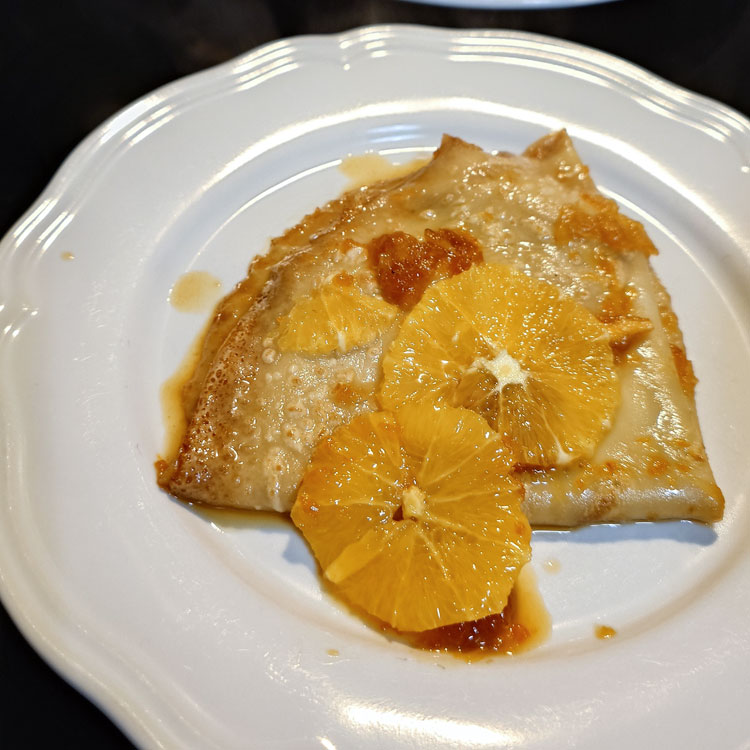
Gegessen
Libanesische Spinatteigtaschen (1,60€/Stück) von C’est bon in der Währinger Straße. Ein Schnittlauchbrot (4,60€) und eine sehr mächtige Schoko-Eierlikör-Kuppel (5,60€) im VIOLA. Handgemachte Pasta mit Zwiebel-Walnuss-Petersil-Sahnesauce, Wirsingchips mit Sesam, Eierreis mit Kraut, italienische heiße Schokolade, gedämpften Schokokuchen und noch ein paar mehr Snacks von meiner WG, direkt an meinen Schreibtisch zum MA-Endspurt. Krautwickerl mit Reis-Erdnussfüllung. Krapfen von Ströck (1,05€), Felber (1,50€), und Öfferl (3,60€), letzterer mit bemerkenswert guter Marillenfüllung. Ein exzellentes Himbeer-Financier vom Parémi.
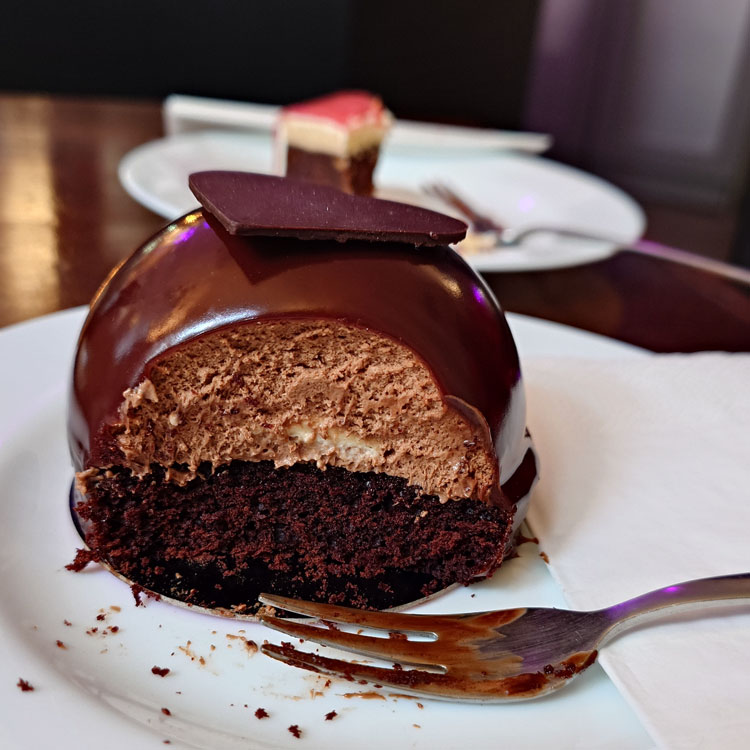

Kohlrabisuppe, Karfiolmousse, Cordon Bleu und Powidl-Tascherl im Recnizek (1090) – so außerordentlich gut, dass ich noch einen extra Post dazu schreiben werde.
Getrunken
Selbstgemixten Mandarin Vodka Sour, inspirert von GAG432: Ein bitteres Heilmittel. Ich hatte grad Kichererbsenwasser da, also nahm ich das statt einem Eiweiß – ich werd noch ein bissl am Rezept tüfteln und es dann verbloggen!

Sign Lounge
Eine ziemlich gute Whisky-Sour-Variante mit chinesischem Sherry, Angostura Bitters und Honig-Quittenstaub auf Empfehlung des Barchefs in der Sign Lounge (1090), in die ich spontan nach dem Reznicek gestolpert bin. Meine Begleitung trank den Rice Rice Baby von der Karte (15€), mit Sake, deutlicher Marzipannote und Limette, sehr cremig dank Eiweiß und Kokosmilch, obenauf Shiso-Umeboshi-Algen-Pulver und ein süßer Reiscracker. Asiatische Einflüsse waren in der ganzen Karte herauszulesen, auch Begeisterung für Fermentation, z. B. in einem Kimchi Martini oder einer Daiquiri-Variante mit Koji.


Die Bar war mir diesmal um Welten sympathischer war als bei meinem letzten Besuch 2019 (s. Zuckersüß 350) – vielleicht weil ich direkt an der Theke saß und die Begeisterung des Bartenders für sein Handwerk ganz und gar zu mir herüberschwappte? Die Playlist war cool (alt!), wenn auch konzeptuell sehr losgelöst vom Rest der Bar – ich habe Knock on Wood in der Version von Eddie Floyd und Rip it Up von Little Richard shazamed. Das Ambiente wirkt weiterhin ein kleines bisschen in-den-2010ern-steckengeblieben (so viel Plastik, so riesig/hallig), und ich fühlte mich im sehr klassisch aufgetakelten Publikum nicht so richtig daheim (mein Cocktailbar-Style ist come as you are). Dennoch: die Sign Lounge ist jetzt jedenfalls zurück auf meiner gedanklichen Wien-Cocktail-Karte!
Gesehen
Tinker Tailor Soldier Spy – sehr verwirrend und schreckliche Hairstyles! Guardians of the Galaxy, der mir als Teil des Superhelden-/SciFi-Kanons verkauft wurde, weshalb ich ihn fast zehn Jahre nach erscheinen endlich geschaut habe. Naja, immerhin die Musik macht Spaß.
Eine Ausstellung serbischer (?) Comicckünstler_innen im 4lthangrund. Diesen Comic von Vuk Palibrk hier fand ich sehr stark (wenn auch sehr makaber):
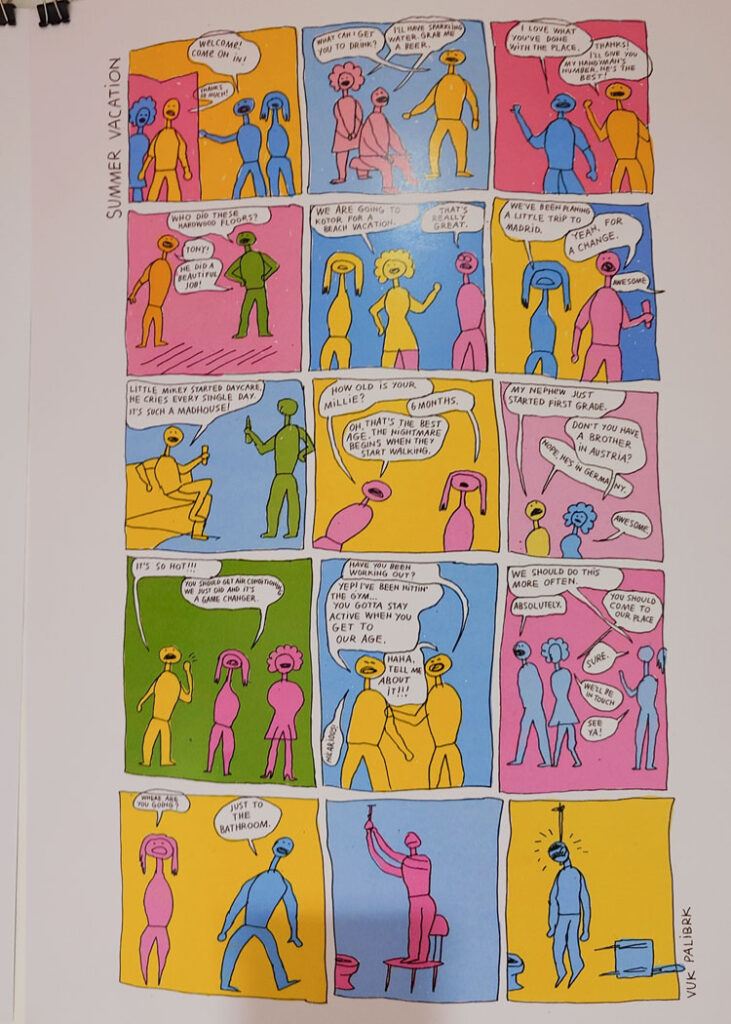
Gelesen
Die Veza-Canetti-Biografie von Sophie Reyer, für eine Podcastfolge (s.u.). Ich finde die Lebensgeschichte enorm interessant, das Buch aber leider ziemlich anstrengend. Es hätte wohl sehr von einem intensiveren Lektorat profitiert, ich bin an einigen Flüchtigkeitsfehlern hängen geblieben und habe mich allgemein am etwas schwülstigen Schreibstil mit enorm vielen Mutmaßungen und übertriebenem Einsatz von Adjektiven gestört.
Die Ferdinandstraße der Wiener Leopoldstadt. Zu Vezas Zeiten ist dies die Straße der Lederhändler. Da existiert ein Grossist neben dem anderen, und die Verkäufer stehen in der Tür ihrer Lager, als wären sie mit nichts beschäftigt. Die Art, wie das ganze Le- ben der Straße sich um sie dreht, hat »nicht im Aussehen, wohl aber im Wesen etwas Orientalisches«, weiß Elias Canetti von dem magischen Ort zu berichten, der die junge Frau offenbar sehr inspiriert hat
Veza Canetti (Sophie Reyer), S. 51
Gestrickt
Endlich wieder ein paar weitere Reihen beim Klimawandeltuch! Ich hoff, ich bin bald fertig. An diesem Wochenende ist übrigens Kick-Off für das 2024er-Knit-Along dazu.
Veröffentlicht
Im Blog: Tahini-Ahornsirup-Zimt-Cupcakes
Anderswo: Meine Masterarbeit!!! Endlich! Wobei, veröffentlicht ist noch zu viel gesagt, in der Bibliothek und bei den Uni-Wien-u:theses wird sie wohl erst in ein paar Wochen stehen. Ich werde dann jedenfalls nochmal drüber schreiben.
Gerstl & Marie #39 Die Unsichtbare: Veza Canetti für OH WOW. Für diese Folge, die wieder gemeinsam mit meiner Kollegin Anna Muhr entstanden ist, habe ich Sophie Reyer’s Veza-Canetti-Biografie gelesen (s.o.) und Künstlerin Gertrude Moser-Wagner in der Ferdinandstraße im Zweiten – vor Veza Canettis ehemaligem Schreibhaus – interviewt. Außerdem bin ich sogar kurz zu hören, ich glaube, das war das erste mal vorm Mikro seit einem Jahr!
Veza Canettis Lebensgeschichte hat mich schwer beeindruckt / schockiert, sie stand ihr Leben lang im Schatten ihres berühmten Mannes, ihre eigenen Werke blieben unentdeckt. Dazu kommt die Verfolgung, der sie als Jüdin Anfang des 20. Jahrhunderts in Wien ausgesetzt war. Ich muss unbedingt eines ihrer Bücher lesen, vielleicht fang ich gleich mit „Die gelbe Straße“ an, das in den 1930ern in der Ferdinandstraße spielt.
Hier folgt die längste Linksammlung seit Langem:
Rezepte
KP+: Jammy Rhubarb Cookies + A Rhubarb Cream Cake (€)
Der whipped mascarpone custard schaut nach einem Rezept aus, das ich in mein Standard-Füllungs-Repertoire aufnehmen werde, Nicola Lamb schreibt darüber: „I’m very happy about this stabilised cream, too. I was finding standard creme legere (pastry cream + cream) a bit too soft to work with for a layer cake, but adding mascarpone – what an iconic ingredient – makes it perfect for stacking.“
Cheddar Scallion Scones with Jalapeno Agave Butter Recipe – Serious Eats
Klingt super! Wo krieg ich Jalapenos her?
Texte
Geheimplan gegen Deutschland – correctiv.org
Rechtsextreme einfach völlig jenseitig.
Sellner ergreift das Wort. Er erklärt das Konzept im Verlauf des Vortrages so: Es gebe drei Zielgruppen der Migration, die Deutschland verlassen sollten. Oder, wie er sagt, „um die Ansiedlung von Ausländern rückabzuwickeln“. Er zählt auf, wen er meint: Asylbewerber, Ausländer mit Bleiberecht – und „nicht assimilierte Staatsbürger“. Letztere seien aus seiner Sicht das größte „Problem“. Anders gesagt: Sellner spaltet das Volk auf in diejenigen, die unbehelligt in Deutschland leben sollen und diejenigen, für die dieses Grundrecht nicht gelten soll. Im Grunde laufen die Gedankenspiele an diesem Tag alle auf eines hinaus: Menschen sollen aus Deutschland verdrängt werden können, wenn sie die vermeintlich falsche Hautfarbe oder Herkunft haben – und aus Sicht von Menschen wie Sellner nicht ausreichend „assimiliert“ sind. Auch wenn sie deutsche Staatsbürger sind. Es ist gegen die Existenz von Menschen in diesem Land gerichtet.
Das wäre ein Angriff auf das Grundgesetz – auf das Staatsbürgerrecht und auf den Gleichheitsgrundsatz.
Braune IT und rechte Influencer – netzpolitik.org
Ein niederbayrischer IT-Unternehmer hat auf dem Sellner-AfD-Treffen eine rechtsexteme Creator-Agentur gepitcht.
Das Mittel der De-Monetarisierung setzt YouTube vermehrt gegen fragwürdige, aber oft gerade noch legale Inhalte ein: Sie können zwar auf der größten Videoplattform der Welt erscheinen und sie als Distributionsplattform einspannen, nicht aber direkt Einnahmen über Werbeanzeigen erzielen. Das wird für einige Nutzer:innen aus rechtsextremen oder verschwörungsideologischen Ecken zunehmend zum Problem: Weltweit suchen sie nach Wegen, wie sie sich über ihre Inhalte dennoch finanzieren können. Dabei setzen sie etwa Links zu PayPal oder Patreon unter ihre Beiträge, bauen Werbeblöcke in ihre Videos ein oder tragen Kleidung mit dem Namen eines Sponsors – um auch ohne YouTube Einnahmen zu erhalten.
Genau dabei soll Mörigs Agentur helfen. Auf der noch nicht veröffentlichten Website, von der wir mehrere Screenshots veröffentlichen, wird eine Agentur vorgestellt, deren Namen wir nicht nennen, um keine Werbung für sie zu machen. Auf der Seite ist Arne Friedrich Mörig samt Handynummer und Mailadresse als Kontaktperson aufgeführt. Darüber angeschrieben, freute sich Mörig „über Ihr reges Interesse an unserer noch so jungen Agentur.“ Fragen wollte er erst beantworten, wenn wir unter anderem unsere Quellen offenlegen – also gar nicht.
Interview Friedrich Zawrel | gedenkstättesteinhof.at
Im Zuge der correctiv-Recherchen oben teilte ein Bekannter diesen Zeitzeugenbericht eines Wieners, der als Kind nationalsozialistische Pflegefamilien/Kinderheime/Psychatrien durchstehen musste, trotz aller Gräuel überlebt hat, aber dann in den 1970er Jahren abermals von einem NS-Psychater als „seelisch abnorm“ eingestuft wurde. Sehr hart zu lesen.
Und da hat er gemeint, wir können wieder auf die Gruppe gehen, und da habe ich dann gesagt zu ihm: „Herr Doktor, bitte können Sie mir etwas geben. Wenn ich die Unterhose anziehe, ich reiße das immer auf, das bleibt immer kleben und so.“ – „Nein, das ist nicht notwendig. Es soll schon ein bisschen wehtun, lange wehtun, denn dann merkst du dir besser, dass so etwas verboten ist, was du getan hast.“ Ich habe einem bittenden Menschen, einem Kranken, ein paar Brotreste gegeben, und das war im Dritten Reich ein Verbrechen. Und der Supperer ist dann wieder zu mir, mit mir zu dieser Jugendgruppe gekommen, und da bin ich wieder an dem Saal vorbeigegangen, aber jetzt hat es mich schon geschüttelt. Jetzt habe ich erst gesehen, wie groß dieser Saal eigentlich war, nur er war leer. Und wenn mich heute einer fragt, also was mir persönlich nähergegangen ist, wenn man so will, der volle oder der leere Saal, werde ich immer sagen, der leere Saal. Nicht, weil da sind mir die Worte vom Spiegelgrund wieder eingefallen: „Die Nazi bringen alle Depperten um.“ Das ist ja dort Gesprächsstoff gewesen. Jedenfalls dieses Ybbs, das gehört wohl zu den traurigsten Erinnerungen an meine Jugendzeit im Nationalsozialismus.
A new global gender divide is emerging – FT.com (Web Archive)
ohje.
So how should we make sense of reports that Gen Z is hyper-progressive on certain issues, but surprisingly conservative on others? The answer, in the words of Alice Evans, a visiting fellow at Stanford University and one of the leading researchers on the topic, is that today’s under-thirties are undergoing a great gender divergence, with young women in the former camp and young men the latter. Gen Z is two generations, not one. In countries on every continent, an ideological gap has opened up between young men and women. Tens of millions of people who occupy the same cities, workplaces, classrooms and even homes no longer see eye-to-eye.
I’m Andrew Tate’s audience and I know why he appeals to young men – The Guardian
Passend zu den ultrakonservativen jungen Männern in der Studie oben:
As with many populists, Tate often talks of a shady plot against him. And like the “prophet narrative” many populists adhere to, Tate predicted he would be deplatformed and then arrested. For his superfans, Tate’s arrest was a sign of credibility, not concern.With his newfound piety comes the promotion of his charitable work, his family and his newfound faith, Islam. Eli says that Tate told him in Dubai that he had converted to Islam for business reasons. There are a lot of young Muslim men in the world, and faith is a good disinfectant for any past wrongs.Tate argues differently, saying that a conservative form of Islam aligns with his traditionalist views on gender roles, relationships and masculinity.
„One Weird Trick“ for effective strategic political communication campaigns – Dave Karpf
Losely related:
Note, by the way, that the outright-Nazi publications aren’t currently big revenue generators for Substack. “We’re going to enforce our Terms-of-Service against sex workers, but not against literal Nazis” is certainly a hill that one could choose to die on, but it is not the hill I would necessarily recommend.
And of course, once Substack has made that statement, what they’ve also done is created another news hook. Because, yeah, theNew York Timesis gonna cover a statement like this. And all that coverage is going to lead many paying readers to communicate to Substack authors “hey, I enjoy your writing, but I’m not okay with my money going to this platform.” And that, in turn, will piss off even more Substack authors. Because as journalistic institutions have crumbled, Substack’s bold value proposition was supposed to be “we’ll make it easy for you, the writer, to cultivate an audience that can let you make a living at this.” That value proposition crumbles when Substack becomes a net negative for independent writers. (As if writers in the 2020s haven’t had to put up with enough bullshit already.)
Wie es jungen Journalist*innen in Österreich geht – tageins.at
Krise des Journalismus, pt. I. Max Miller (der vor einem Jahr als erstes meinen Ö1-Abgang wegen prekärer Vertragsbedingungen in einem Artikel für die Kleine Zeitung thematisiert hat) sagt z.B. das:
Ich kann niemandem mit gutem Gewissen sagen: Hey, das ist eine Branche, in die du gehen solltest. Das ist super und da wirst du einen Job finden und das wird dich glücklich machen. Aber ich persönlich würde momentan trotzdem in keiner anderen Branche arbeiten wollen.
Advertisers Don’t Want Sites Like Jezebel to Exist – 404media.co (via Links I Would GChat You)
Krise des Journalismus, pt. II: Brand Safety, schon wieder so ein bescheuertes late-capitalism Konzept…
But this is unfortunately how the internet works now, and has for a long time: News terrifies brands big and small, to the point where “brand safety” and “brand suitability” have become gigantic industries that have brought even giants like Facebook and Google to heel.
In theory, the “free market” should reward publications that are doing important work. The more people care about a given issue the more they’ll read news stories about it, which should give publications covering it traffic and ad dollars. In reality, the advertising industry has singled out the issues the audience cares about most, like reproductive rights, as unsuitable to sell ads against, even though a ton of people want to read about them. This helps explain the precarity of publications like Jezebel, despite it being more vital to its audience than ever.
Pitchfork’s absorption into GQ is a travesty for music media – and musicians | Music | The Guardian
Krise des Journalismus, pt. III.
Incorporating Pitchfork into a men’s magazine also cements perceptions that music is a male leisure pursuit, and undermines the fact that it was women and non-binary writers – Lindsay Zoladz, Jenn Pelly, Carrie Battan, Amanda Petrusich, Sasha Geffen, Jill Mapes, Doreen St Félix, Hazel Cills; the fearless editing of Jessica Hopper and then the most recent editor-in-chief Puja Patel, to name but a handful – who transformed the website in the 2010s. It also suggests that music is just another facet of a consumer lifestyle, not a distinct art form that connects niche communities worthy of close reading, documentation and, when warranted, investigation.
Celebrities will endorse publishers (and get paid for it) » Nieman Journalism Lab, Predictions for Journalism 2024
Lösungsvorschläge zur Krise des Journalismus, pt. I (bin nicht überzeugt, tbh):
One tactic in the revised toolbox should be the celebrity endorsement or “partnership.” My prediction: Publishers will begin to work with celebs to sell subscriptions and cross-sell awareness. And these partnerships may be paid, maybe even for the first time. Celebrities may have once needed the exposure from us, but it’s publishers that need the attention now. News avoidance just adds fuel to the fire.
The web floods » Nieman Journalism Lab, Predictions for Journalism 2024
Lösungsvorschläge zur Krise des Journalismus, pt. II:
Newsrooms that commit to AI-driven storytelling as a way to cut costs while increasing output will be lost in a sea of similarly bland content and spammy marketing. Newsrooms that cling to traditional SEO and social media tactics will find that they become less and less effective in the face of more and more noise.
In contrast, the newsrooms that survive the flooding of the web are going to be the ones that report deeply, commit to diverse representation, invest in investigative journalism in the public interest, and choose to meet their communities where they’re at by doing things that don’t scale to engage them.
Journalists abandon social media, and news audiences follow (eventually) » Nieman Journalism Lab, Predictions for Journalism 2024
Lösungsvorschläge zur Krise des Journalismus, pt. III (ich wär ja für ein RSS-Revival…):
That’s a tall order, especially as these platforms continue to dominate people’s attention; however, my prediction is that it will continue to grow clearer that separating news — and news consumption — from social media is the best step forward not just for journalists, but the public as well.
Rise of the news DJs » Nieman Journalism Lab, Predictions for Journalism 2024
Lösungsvorschläge zur Krise des Journalismus, pt. IV (ok, den kann ich nicht ganz ernstnehmen):
With the rise of personalization, we’ll see the beginnings of a new journalism craft: news DJs. Their main job will be to edit these automated news presentations. But they will also need to artfully manage the give and take between business prerogatives, machine learning engineers’ priorities, and the ethics of news presentation. This wide range of responsibilities will likely inspire better-heeled newsrooms to hire editorial AI strategists to lend a hand.
Over time, some prominent reporters will retain their direct connection to an audience — but this will be increasingly rare. Instead, reporters will be deployed as elite creators of trusted source material. The economics here might resemble that of tech programmers today: well-compensated and largely unknown to the customer.
Move over podcasts, everyone has a Substack newsletter now – Russh.com (via sent from my iPhone with love)
Den Gedanken find ich interessant (aber gilt doch auch für Blogs??):
What I like about newsletters is the way the format toes the line between journalism and journaling. If podcasts simulate the feeling of juicy conversation over drinks, newsletters evoke intimate correspondence with a friend. It is geared towards individual voices, and exists as a place for the personalities of Instagram and the internet to hand over a piece of their mind, instead of just their moodboard.
The Unified Content Business Model – Stratechery by Ben Thompson
Über Amazons Ankündigung, Prime Video jetzt mit Werbung zu versehen hat sich meine gesamte WG sehr geärgert, so sehr, dass wir da vermutlich bald kündigen werden (weil ganz ehrlich: besonders gut finden wir Amazon im Allgemeinen nicht). Dieser Blogpost von Mai 2023 dröselt Streaming-Geschäftsmodelle im Allgemeinen auf (was meine Sympathie ggü. Amazon allerdings nicht beeinflusst).
The irony of Netflix being both ad supported and subscription supported is that that was the business model of TV; customers paid for cable (which passed along affiliate fees to cable networks and retransmission fees to broadcast networks) and also had to endure advertisements during their favorite shows.
Four Myths of Bundling – Shishir Mehrota
Ähnliches Thema:
In my view, most businesses on the internet have fallen into two buckets.
- The classic models are „superfan“ business models ー products that directly serve a specific set of users who have the willingness to pay and the activation energy to find those services (see Myth 1 for more on this definition). These tend to be transactional businesses ー e.g. Uber charges for rides, and if you don’t have the need for a ride, then your relationship with Uber ends.
- At the other extreme are „nonfan“ business models. These tend to focus on users who are quite willing to spend time on a service, but would likely not participate if asked to pay directly. Many of these businesses are ad-supported ー journalism, social networks, etc. And interestingly, many of these business models were made viable by the advent of ad networks like AdSense ー they couldn’t individually attract sufficient audiences for advertisers, but could participate if they were grouped together with other similar businesses.
Plot Twist – Ann Friedman Weekly
Ann Friedman ist unerwartet schwanger geworden. Ihr seit zehn Jahren laufender Newsletter – ihre Haupteinnahmequelle und wohl einzige soziale Absicherung als freie Journalistin in den USA, so wie ich das verstehe – läuft weiter, mit einem seriellen, vorgeplanten Essay statt wie sonst üblichen aktuellen Links. Ich finde sowohl Inhalt (sie verhandelt ihre Position als Frau-ohne-Kinderwunsch-und-dann-doch-späte-Mutter und Feministin in Zeiten eingeschränkter reproduktiver Rechte in den USA) als auch Form (ihr Versuch, sich als Gig-Worker im Web Mutterschutz/Elternzeit zusammenzuschustern) lesenswert.
Starting this week, deep into Season 41 of my life and Season 10 of this newsletter, I’m taking three months off. Because I am about to have a baby. Not a book baby, a human baby. One that I have grown inside my own body. The internet suggested I “tell my employer” sometime around Week 26, which was back in August. One of the many great things about self-employment is that my employer has known for a lot longer than that. Though, in a way, you are all my employers, too. And here I am notifying you at the last possible moment. I wasn’t really ready to tell you before now.
My Unraveling. I had my health. I had a job. And then, abruptly, I didn’t. – New York Magazine (via Webcurios)
Bei diesem Text konnte ich einfach nicht aufhören zu lesen (und: wie kaputt ist das US-Gesundheits-/Sozialversicherungssystem?!)
As the time came closer, I began to apprehend an uncomfortable truth. The actual medical mystery wasn’t about anything inside me. It was whether the tests were going to point to some far side of this where I got my life back. Was there a future where I could walk out the door on Sunday morning in decent shoes and make it to church? Where I could pick up heavy groceries to put a three-course meal on the family dinner table? Where we could rent a rowboat? Where I was a helpful and economically viable member of the household?
If One Part Suffers, by Michelle Orange (via Webcurios)
2014 habe ich im SZ-Magazin eine ähnliche Geschichte gelesen, die mir bis heute im Gedächtnis geblieben ist: Der Stumpf. Warum ein Mann sein Bein mit einer Guillotine abgehackt hat.
The wish behind all of Robert’s planning was not to destroy his body but to alter it. I had come to meet him, this smiling, summer-dude vision in wraparound sunglasses, sweat-wicking shorts, and white Air Monarchs, because for at least forty of his fifty-two years, Robert has wanted nothing more than to shear away one of his two healthy, perfectly functioning legs. His physical form, tallish and solid-built, feels “overcomplete,” he’d told me repeatedly, possessed of an extra, deeply unwanted thing.
The Unstoppable Rise Of The Sheer Wedding Dress – Vogue.co.uk
Über die Korrelation von halb-durchsichtigen Hochzeitskleidern und instagrammability… Das erwähnte vierlagige (immer durchsichtig werdendere) Kleid von Ivy Getty (designt von John Galliano) find ich sehr cool, besonders das Spiegel-Überkleid.
Plus, sheer doesn’t necessarily mean sexy. It’s a quality of fabric often employed by designers to show off intricacies in their design: embroidery, ruffles, or beading are all easier to admire when there’s negative space. Wedding gowns, especially couture pieces, often take months to make and require the help of a number of talented seamstresses. This is a way to let their work shine – both for the bride and her guests in person, and when the pictures are later shared online. “Sheerness allows for contrast and tactile qualities coming through,” says Cook Smith. “With Instagram, so many of the photos people are attracted to are because of the contrast where you see the details. When there’s white-on-white, it can look flat.”
The age of average — Alex Murrell (via Links I Would GChat You)
Über die ästhetische Gleichförmigkeit unserer Zeit.
I believe that the age of average is the age of opportunity. When every supermarket aisle looks like a sea of sameness, when every category abides by the same conventions, when every industry has converged on its own singular style, bold brands and courageous companies have the chance to chart a different course. To be different, distinctive and disruptive. So, this is your call to arms. Whether you’re in film or fashion, media or marketing, architecture, automotive or advertising, it doesn’t matter. Our visual culture is flatlining and the only cure is creativity. It’s time to cast aside conformity. It’s time to exorcise the expected. It’s time to decline the indistinguishable
The tyranny of the algorithm: why every coffee shop looks the same – The Guardian
Passend zu den instagrammable Hochzeitskleidern. (S.a. der vorhergehende Essay des Autors, den ich 2016 schon mal geteilt hatte: Welcome to AirSpace | The Verge)
To court the large demographic of customers moulded by the internet, more cafes adopted the aesthetics that already dominated on the platforms. Adapting to the norm wasn’t just following trends but making a business decision, one that the consumers rewarded. When a cafe was visually pleasing enough, customers felt encouraged to post it on their own Instagram in turn as a lifestyle brag, which provided free social media advertising and attracted new customers. Thus the cycle of aesthetic optimisation and homogenisation continued.
Will the Millennial Aesthetic Ever End? – The Cut
Der Text ist von 2020, aber ich glaube, bisher hat sich diesbezüglich noch nicht so viel getan… Am spannendsten im ganzen Artikel finde ich die Gedanken zum Fehlen der Millenial Aesthetic. Also auch kritisch mir selbst gegenüber – ich beobachte, dass ich neueröffneten Restaurants, die nicht wirken, als hätten sie ihr komplettes Konzept, von Speisen über Webseite, Einrichtung und Kund_innen-Ansprache durchdacht, eher skeptisch gegenüber stehe (zuletzt: Crazy Khinkali).
As the millennial aesthetic grows omnipresent, as its consumers grow more design-fluent, our response grows more complex. We resent its absence (Why is this restaurant website so crappy?) but also resent its allure; we resent that knowing the term sans serif does not make you immune to sans serif’s appeal. The desire for individuality rebels against its sameness, even as the sameness feels reassuring, feels good.
Disney’s Taylor Swift Era – Stratechery by Ben Thompson
Taylor Swift und Disney irgendwie wiederkehrende Themen in meinen Linksammlungen :’D. (Der Text ist von August 2023).
Disney is, from this point forward, not much different than Taylor Swift: sure, there is money to be made (hopefully) in areas like streaming, but the real durable value and outsized profits will come from real life experiences. This is, to be sure, a good business, but it has its limits: it is remarkable that Swift performed six shows in seven nights in Los Angeles, but it was still only six shows; concerts don’t scale like CD sales used to. Disney, similarly, only has so many theme parks, that only accommodate so many people, and operating those theme parks takes significant ongoing resources.
It’s interesting, then, to observe how differently Swift and Disney are perceived at this moment in time: I opened with Simmons analogizing Swift to Jordan, and I think it’s a fair comparison; the reality of the fractured world wrought by the Internet is that any star who can emerge from the noise becomes bigger than anything we have seen before, from hunger for a unifying experience if nothing else, and admission to that experience becomes valuable through unprecedented demand combined with physically limited supply.
The Strangely Beautiful Experience of Google Reviews – Longreads
Google-Bewertungen sind mehr als nur Qualitäts-Einschätzung, argumentiert Will McCarthy:
I slept under the overpass that night, and in the morning, I wrote a review: “Reasonably good bridge. A little loud for sleeping.” I gave it four stars. After I set off on my bike, I couldn’t stop thinking about it. Because of Google Reviews — because multiple people took the time to review this squat bridge in the middle of nowhere — I felt like I was part of some shared human experience, the newest member of an obscure club. Maybe the other reviewers would disagree, but this moment felt powerful, like seeing other people’s names etched into a park bench or finding yourself deeply moved by the graffiti inside a public bathroom stall. But it was also weird: This tool for consumer reviews had become a digital guestbook for anything and everything in the world.
Dream of Antonoffication – The Drift (via Links I Would GChat You)
Mitch Theriau über die Rolle des Pop-Musikproduzenten, und die Ära des Jack Antonoff:
In the bluntest terms, the DIY minimalist song is an agile song. It is a born-digital object optimized for frictionless circulation — the ability to function as audio furniture for viral videos, fit in on a variety of algorithmically curated playlists, play unobtrusively in what passes for public space in contemporary American life, generating revenue along the way. If music was transfigured into a commodity at the mythic dawn of capitalism, today it has gone through an additional transformation into content, a slippery term that media scholar Kate Eichhorn defines as “something that circulates for the sake of circulation” and accrues more value the more it circulates.
Passionate Kisses: The Soundtrack at CVS – The Paris Review
Vom selben Autor wie der oben verlinkte Text. Ich bin echt neidisch, wie gut er schreibt, v.a. weil dieser Essay einen ähnlichen Ausgangspunkt hat wie mein letzter Text für die Effilee, über Musikkonzepte in Restaurants.
Hell is other people’s music. But whose music is the CVS soundtrack? The store’s music vendor is Mood Media, formerly Muzak. While that company made its name with what we’d today call original content—light instrumentals composed for background listening—it eventually pivoted into the playlist business, curating “channels” of already-existing vocal pop music for their clients. It’s easy to imagine each major chain laying claim to its own channel to create its distinct emotional climate, whether they use Mood or one of its few competitors. Trader Joe’s is peppy and lightly eclectic: Motown, tasteful eighties hits. H&M is corporate hipster: late-period Jens Lekman. Ditto Urban Outfitters, which used to put out a yearly mixtape: “Halloween Head” by Ryan Adams, “Slow Me Down” by Emmy Rossum. Breezy yacht rock diffuses through the faux-Egyptian catacombs of the Cheesecake Factory. Whole Foods is largely silent.
Inflicted listening redux – chump atlantis
Und hier noch Mitch Theriaus Newsletter, in dem er über den Schreibprozess des CVS-Soundtrack-Texts reflektiert. Interessanter Blick in den Autorenwerkzeugkasten!
Originally, I had imagined that my piece would try to catalog, in very abbreviated form, the respective sonic environments of many retail/food chains. This turned out to be too much for a short essay to bear—especially one that ultimately tries to focus on one particular place. Here’s a paragraph from an early version that didn’t make it into the final piece:
In other places, things have gotten a little weird. One Bay-Area café/juice bar chain has started to favor the active-rock stylings of Three Doors Down. “Cool Kids,” an alt-pop earworm by Metric tribute band Echosmith, has worked its way into heavy rotation on the otherwise all-classic-rock-all-the-time playlist at Guitar Center, as if someone up in upper management had Googled “guitar band + women” in a panic. Starbucks does not seem to bother with all the restrained singer-songwriter vibes and lite world music anymore. I recently heard “Gasolina” at my local store, at something approaching club volume. It struck me as the perfect soundtrack for a store that has abandoned the dream of being a “third place” type hangout and embraced its new role as an anonymous node in the app-ordering economy. People walk in, grab their mobile order, and leave without saying a word. “Gasolina” presides over this speedup, even as it tells customers effectively to get out.
This is one of those gathering-steam grafs that one writes when one is trying to find a way into a piece. The observations are all true, but they’re treated in a slightly flip or callous way. At the level of flavor, the paragraph encourages ridicule rather than curiosity. Still, its content does resonate with a sense that Musson picks up on and amplifies in his mixtapes: in so many public sonic environments, especially since the relaxation of most COVID protocols, the vibes are majorly off.
A short history of the daily planner – Jillian Hess (via Austin Kleon)
Mir war nicht bewusst, dass das in die Zukunft planen ein eher neues Phänomen ist! (Über Kalender für die Planung, und das Zuckersüß als Chronik habe ich btw 2018 schon mal im Blog nachgedacht).
Today we tend to think of daily planners as records of what will happen. But most of its early users saw daily blank space in their notebooks as a way to record what had happened. It was a way to account for one’s time and how it was spent (as George Washington noted).
It’s not until the 20th century that we see pocket diaries regularly used for recording future events. In fact, the word “planner”—as in an object used to facilitate planning— wasn’t introduced into the English language until the 1970s (according to the Oxford English Dictionary).
All Of My Friends Are Eating Meat Again- Byline
It Me.
Most of us cut it out at the start of university. A cocktail of things: the booming 2010s vegan YouTube movement, right-eyed tertiary education-ed activism, the rise of substitute meat, a series of gorecore vegan documentaries doing the rounds on Netflix, the cause du jour being environmental activism and a new way to control food that didn’t publicly read as restriction.
But then, in the past year, something changed. You’d go out to dinner with your vegan friends and they’d sheepishly rip off a piece of the burrata, just to see. Your vegetarian friend would say to the waiter that it’s fine that the dish is made with fish sauce, that bone broth isn’t a big deal. And then you’d turn and your pescatarian friend would have barbeque sauce crime scened all over their face, sucking on a rib like it’s a dummy. Suddenly, all my friends ate meat. And did I.
Ernte & Energie: PV-Anlagen im Feldversuch – noe.orf.at
Agri-PV ist mir erstmals bei meiner Recherche zu Wein & Klimawandel fürs Ö1-Kulinarium im September 2022 untergekommen, offenbar wirds jetzt schon breiter ausgerollt (aber immer noch im Versuchsstadium):
Eine Apfelplantage wurde mit Photovoltaik überdacht, daneben eine gleich große, nicht überdachte Plantage angelegt. Im zweiten Jahr mit der ersten Ernte stellte sich heraus, dass die überdachte Plantage bessere Erträge geliefert habe als die herkömmliche, sagte Oliver Eisenhöld: „Das kommt einerseits von der Beschattung durch die spezielle Form der semitransparenten Module, andererseits schützen diese auch vor Starkregenereignissen oder Hagel.“
„iPodder“: Neuer Trend Podcasting | STERN.de
Dieser Artikel von 2004 hat mich amüsiert:
Die gestressten PC-Anwender können sich gar nicht so schnell auf neue Trends einstellen, wie sie inzwischen erfunden werden. Gerade erst haben sie sich daran gewöhnt, sich Nachrichten per RSS-Feed auf den Desktop schreiben zu lassen, da wird bereits das Podcasting populär. Um bei diesem neuen Trend mitmachen zu können, wird nur das kostenlose „iPodder“ benötigt. Dabei handelt es sich um ein Programm, das in der Lage ist, die speziellen „RSS 2.0 Feeds“ zu abonnieren. Das sind Datenströme, die nicht nur Nachrichtenschlagzeilen auf den Bildschirm des Anwenders übertragen, sondern dank so genannter „enclosure tags“ auch Dateien aus dem Netz herunterladen.
USATODAY.com – Radio to the MP3 degree: Podcasting
Ebenfalls sehr spannend, ein Artikel über Podcastpotentiale und Apples Haltung zum Thema, 2005:
Apple, in particular, is in a prime position to make podcasting significantly easier — but probably won’t. It has ignored requests from Curry and other technologists to discuss the matter, and declined USA TODAY’s interview requests for this story. Having sold 10 million iPods, Apple commands 90% of the market for MP3 players with hard drives. Last month, it introduced the $500 Mac mini, its first economically priced computer, which comes with entry-level music-recording and mixing software, called GarageBand, which many podcasters are using to produce shows. Podcasters would like nothing better than for Apple to supply recording and mixing software specifically designed for podcasting on Mac computers. They would also like to see the iPod tweaked to make it easier to do such things as subscribe to a podcast and fast-forward through programs. Such moves would tend to foster the proliferation of grass-roots digital content, for which Apple gets no revenue. Besides, Apple owes allegiance to the established music industry, which agreed to a breakthrough licensing deal, paving the way for the Apple iTunes store to sell individual song downloads for 99 cents each. Single downloads helped make the iPod a big hit.“ I believe Apple has probably sold their soul to Hollywood and just cannot integrate podcasting into their business plan,“ Curry says.Some experts believe that Apple can well afford to stand pat — as long as the iPod continues to dominate the portable MP3 player market. „Most people are going to go out and get an iPod to participate, so any increase in podcasting is going to benefit Apple,“ says Piper Jaffray analyst Gene Munster.
Warum Auracast Bluetooth revolutioniert – Futurezone (via Georg Gfrerer LinkedIn)
Das ist cool!
Mit der Technologie ist es möglich, dass sich mehrere Empfänger mit ein und derselben Audioquelle verbinden. Man kann es sich wie einen WLAN-Hotspot vorstellen, mit dem sich eine große Zahl an Handys oder Laptops verbinden können, etwa bei Veranstaltungen.
Mithilfe von Auracast kann ein solcher Bluetooth-Hotspot entstehen, mit dem sich alle Kopfhörer in der Umgebung verbinden lassen. Neben Kopfhörern können zudem Bluetooth-fähige Hörgeräte den Auracast-Broadcasts beitreten, sofern sie das Protokoll unterstützen.
Die maximale Anzahl an Empfänger*innen ist tatsächlich unbegrenzt, wie es auf der offiziellen Bluetooth-Webseite heißt. Möglich wird das dadurch, dass es keine 1:1-Verbindungen zwischen Sender- und Empfängergeräten gibt. Stattdessen wird das Auracast-Signal ähnlich wie bei einem Radiosignal einmal abgeschickt und kann dann von anderen Geräten empfangen werden. Die Latenz soll dabei mit 20 bis 40 Millisekunden minimal sein.
Frauenverachtung, wie sie im Buche steht – Artemisia.blog
Diese Ausstellung bzw. das Fotobuch klingen sehr interessant:
Am nachhaltigsten – im Positiven wie im Negativen – beeindruckte mich Caroline Heiders Arbeit – eine Performance-Lecture und Fotoserie – „Reading Photoguides“. Die Künstlerin nahm sich dafür Fotohandbücher vor. Obwohl diese noch nicht so alt sind, wähnt man sich angesichts der dort verwendeten Bildsprache in den 1950-Jahren. Die Fotos dienen augenscheinlich „nur“ dazu, entsprechende Technik zu erläutern – doch sie zeigen hauptsächlich sexualisiert dargestellte Frauen mit wenig Textil am Körper. Eine posiert im erotischen Fitnessdress. Eine greift sich, bekleidet nur mit Nagellack und Armreif, selbst auf den Hintern. Ein liegender Akt trägt zwar keinen Kopf, dafür aber einen Apfel (wie hintersinnig, diese Metaphorik!). Akte sind logischerweise ausschließlich weiblich. Sonst ist für Frauen noch die beliebte Mutter-und-Hausfrau-Rolle vorgesehen.
infogoop – Joshua Citarella
Über den weirden Produkt-Overlap zwischen goop und infowars.
In 2015, while I was collaborating with Brad Troemel on UV Production House, we observed a bizarre trend on Pinterest. Alternative health recipes would be posted by seemingly disparate ends of the political spectrum. Items like solar panels and home gardens could be found in the bizarre overlap between doomsday preppers and ethical consumers. Beneath their branded exteriors lies a shared material politics of hyper-individualism and self-sufficiency. In either worldview, the possibility for optimism and collective action is totally foreclosed. Each group anticipates a financial, environmental or social catastrophe. In preparation for the inevitable crisis, consumers may choose to respond with self care and composting or by stockpiling arms and dried goods in an underground bunker. While these groups may have different consumer preferences and different cultural narratives, both divorced dads and yoga moms agree that each individual is responsible for the fate of the world.
Audio/Video
Thirsty Eyes – 838
Hab vor einiger Zeit den Gitarristen dieser Band auf einer Party getroffen. Und finde es sehr lustig, dass ich aus irgendeinem Grund den Film Wer früher stirbt, ist länger tot mit diesem Sound assoziiere??
Post Malone: Tiny Desk Concert
In den vergangenen Wochen habe ich mich gefühlt durch alle Tiny Desk Concerts gehört, das ist eines meiner liebsten.
Amaarae: Tiny Desk Concert
Und das! (Amaarae kannte ich vorher nicht).
Mobile reverse engineering to empower the gig economy workers and labor unions – media.ccc.de
Für diesen Talk vom 37c3 will ich als ~Arbeitsrechtsultra~ eine Empfehlung aussprechen, denn auch (besonders?) Plattform-Arbeitgebern wie in diesem Fall Essens-Lieferdiensten darf man ungerechte Behandlung ihrer Mitarbeitenden nicht durchgehen lassen. Und als betroffene_r Rider_in hat man Handlungsspielraum, wie die beiden Vortragenden deutlich machen:
This talk will describe our efforts to introduce a new toolkit and mindset for unions and gig workers, which is essential in an era where, for a growing number of people, „an app is their boss“.
Our work highlights the critical role of technical literacy in improving workers‘ bargaining power, particularly in collective bargaining. By demystifying the technology that governs them, we aim to equip workers with the tools to assert their rights and shape a fairer working landscape.
Infrastructure of a migratory bird – media.ccc.de
Noch ein 37c3-Talk, über die unentwirrbaren Verbandelungen von Natur und Technologie bei Zugvögeln. Enorm STS-y. Fun fact: Je nachdem, welche Route die Waldrapps wählen, kostet ihre Beobachtung mehr oder weniger Geld – denn außerhalb der EU fallen teils hohe SIM-Roaming-Kosten an.
What does it take to create a „wild animal“? While one might think „wildness“ implies the absence of humans, in the age of the anthropocene and rapid climate change, the opposite is the case. It requires the development of an extensive, more-than-human-infrastructure. Our talk is based on artistic research into the ongoing rewilding project of the Northern bald ibis (Waldrapp), a large migratory bird, that has become extinct north of the alps in 1621 and are being released into the wild since 2013. The output of this research was rendered into a website which serves as a departure point of our talk.
We outline the heterogeneous elements that make up the infrastructure of the rewilding project and what kind of situations are being produced therein. The graph of „the infrastructure of a migratoy bird“ shows relationships between social, technological, informational, and ecological elements which make up the anthropogenic ecosystem in which the bird is becoming wild again. The objective was to visualise and comprehend the intricate network of data, energy resources, and dependencies deeply enmeshed within the project’s framework.
Geschichten aus der Geschichte: GAG432: Ein bitteres Heilmittel
Über die Ursprünge der Angostura-Bitters.
The Sporkful: Reheat: Two Books For The Food Science Nerd In Your Life
Das vorgestellte Buch von Harold McGee, Nose Dive, habe ich seit meiner Ö1-Sendung über das Räuchern im Regal stehen, aber noch nie durchgelesen. Nehm ich mir jetzt wieder vor!
PERFECT DAYS official movie site (via Webcurios)
Den Film habe ich Ende 2023 im Kino geschaut (s. Zuckersüß 462), ich wusste nicht, dass es eine so tolle Begleitwebseite dazu gibt!
lichterloh a/v snack €2: kitchen opera (via Kunst & Klischee Podcast)
coole Idee!
DVD und Vinyl gegen digitale Verlustängste – ORF Topos
Der hier eingebettete historische TV-Beitrag über die „Weltpräsentation des neuen digitalen Schallplattensystems“ in Salzburg 1981 ist sehr lustig aus heutiger Perspektive.
Sonst So
Diagram Website – An internet map (via Kopfzeiler.org)
Eine Landkarte des indie web. Zum Stundenlang herumklicken!
Sunday Sites
Oh wie cool, quasi ein digitaler Bastelnachmittag, statt Papier, Kleber und Schere halt mit HTML und CSS.
Webcurios
Über unendliche Link-Verkettungen bin ich zu diesem Blog gekommen, das man grob als Zuckersüß-Linksammlung-on-stereoids beschreiben könnte! Ich habe mit einem einzelnen der SEHR langen Posts mehr als vier Stunden zugebracht, die Link-Auswahl ist höchstspannend, der Schreibstil sehr amüsant und die Grundhaltung des Autors mir sehr sympathisch.
Why do you do this?
That’s a good question. Mostly compulsion, if I’m honest (it’s a bit like a tic at this stage, and I worry if I didn’t have this outlet I would start scrawling urls on park benches or all over the walls of my house, like some sort of awful, never-to-be-discovered (even posthumously) outsider artist).
But, to be serious for a second, it’s because the web is obviously horrible and has ruined us as a species, but it is also amazing because of all the incredible, strange, mad, odd, obsessional, creative, interesting, sad, terrifying, stupid, evil, cruel, selfish, venal, poignant, funny, disturbing and utterly human content that people put on it. I think it’s A Good Thing that there are some places online that help spread the word about some of all of the amazing stuff that exists out there, outside of the walled gardens of many people’s online experience. You don’t get this shit on Insta, is what I’m saying.
GeoSpy AI (via Webcurios)
Das ist so gruselig! Ein Bilderkennungsalgorithmus, der genaue Koordinaten zum Aufnahmeort ausspuckt.
Literaturpodcasts.de
Es gibt jetzt eine Sammelseite für Literaturpodcasts, so ähnlich wie wisspod, wies aussieht.
Vom Einzelbild zum Projekt: Angles Mortes – StreetLetter
Der Fotoband wirkt interessant.
Ich habe immer wieder diese Aufkleber mit dem “Angles morts” gesehen und dachte, hey, das ist dein Titel, nicht Sonntagsfahrverbot. Dein Titel ist der tote Winkel, den wir alle in irgendeiner Form haben. Ich war dann einmal auch unterwegs und wollte mehr grafische Sachen machen, aber die sind jetzt gar nicht im Buch drin. Das gehörte nicht rein. ”
Cursor party! Get multiplayer cursors on your own website
Das ist ein lustiges Feature!
Backkatalog

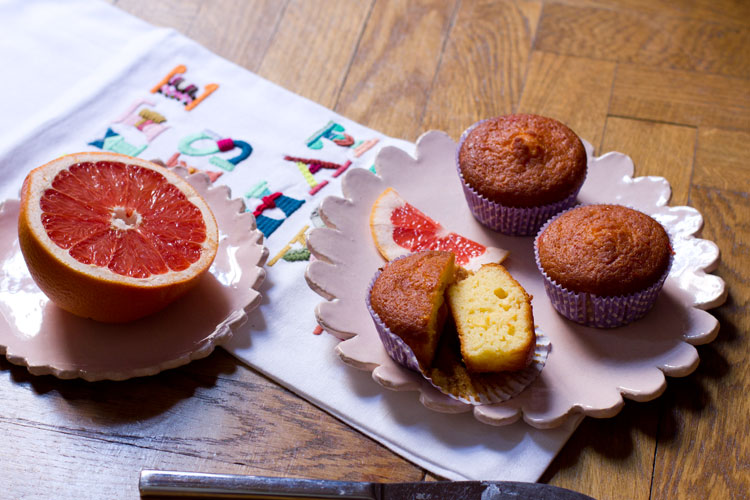

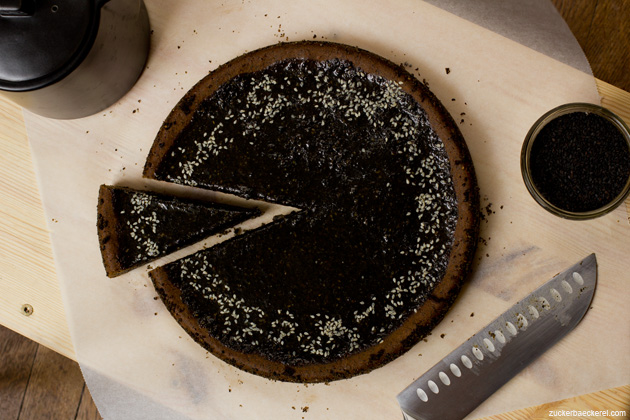









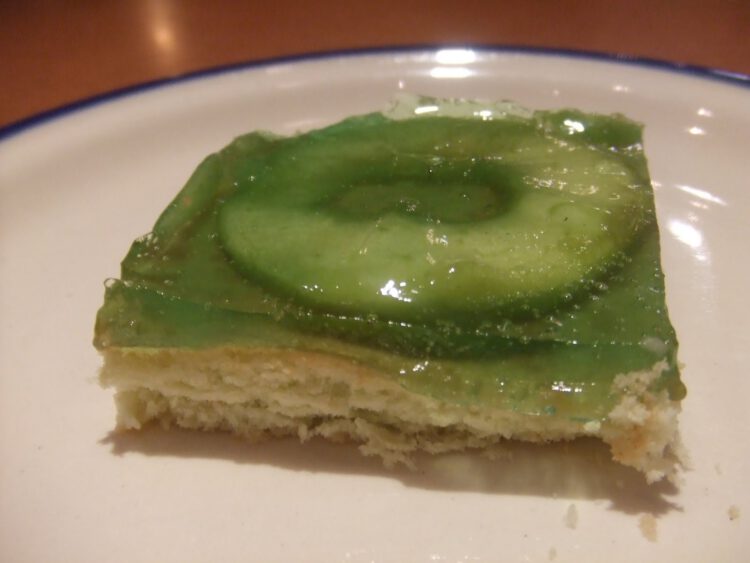
- 2023: Ricotta-Olivenöl-Muffins
- 2022: Grapefruit-Muffins
- 2021: Zuckerstreusel-Cookies
- 2020: Mochi-Kuchen mit schwarzem Sesam
- 2019: Olivenöl-Brownies mit Pistazien
- 2018: Tarte aux pommes
- 2017: Haferflockencookies mit Rosinen
- 2016: Matcha-Blondies
- 2015: Schoko-Ingwercookies
- 2014: Zimtschnecken
- 2013: Schokoladentortina
- 2012: Waffelsdorfkuchen
- 2011:Baumkuchen-Lamingtons
- 2010: Waldmeisterapfelkuchen – Grüner-Glibber-Kuchen

 Hi, ich bin Jana. Seit 2009 veröffentliche ich hier wöchentlich Rezepte, Reiseberichte, Restaurantempfehlungen (meistens in Wien), Linktipps und alles, was ich sonst noch spannend finde. Ich arbeite als Redakteurin bei futurezone.at, als freie Audio-/Kulinarikjournalistin und Sketchnoterin. Lies mehr über mich und die Zuckerbäckerei auf der
Hi, ich bin Jana. Seit 2009 veröffentliche ich hier wöchentlich Rezepte, Reiseberichte, Restaurantempfehlungen (meistens in Wien), Linktipps und alles, was ich sonst noch spannend finde. Ich arbeite als Redakteurin bei futurezone.at, als freie Audio-/Kulinarikjournalistin und Sketchnoterin. Lies mehr über mich und die Zuckerbäckerei auf der 

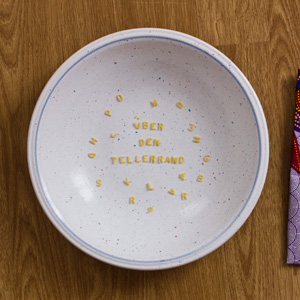 Über den Tellerrand
Über den Tellerrand Bücher
Bücher Zuckersüß
Zuckersüß